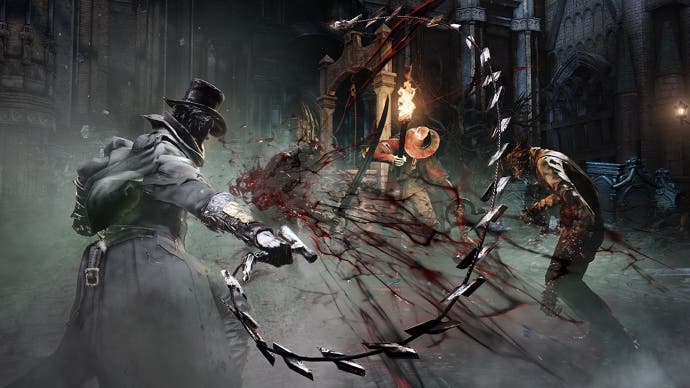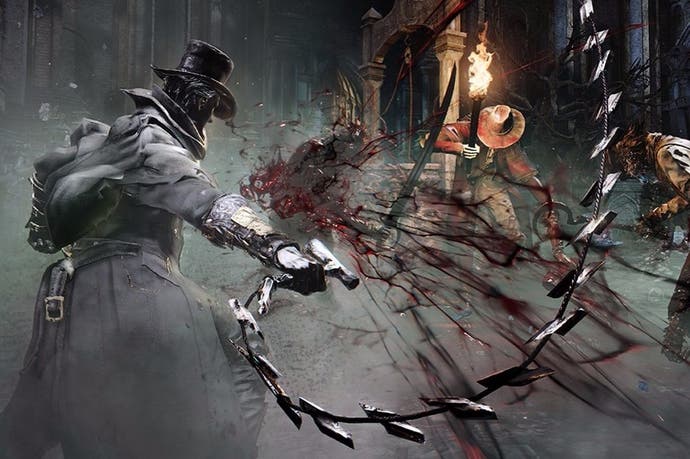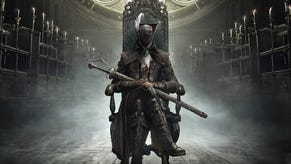Eurogamer's Game of the Year 2015
Spinning a Yharnam.
That's more like it. At the end of last year it was hard not to look back at our top 10 and let out a little sigh of disappointment: it was almost nothing but sequels and expansions, suggesting that the new generation was taking its time to find its feet. 2015, however, saw video games in fine stride. There's quality but also a staggering amount of breadth, a list that has something for everyone (as well as a few notable casualties, so rich were the pickings this year).
There can only be one winner, though, and it might not be the most popular of choices. It's a platform exclusive, which for good reason never goes down too well. It's a stubborn game too, which can scare off those who feel that video games are a more leisurely pursuit. Above all, though, it's a phenomenal achievement where art and vision combine to create one of the finest games of not just this year but any in recent memory. And so it is that From Software's Bloodborne is Eurogamer's own choice for 2015's game of the year. Here's Martin, Jeffrey, Oli and Christian to tell you exactly why.
Living Failure
Martin's 2015 was spent meeting heroes such as Miyamoto, Mizuguchi and Yu Suzuki while getting very upset that everyone at Eurogamer was too busy playing Destiny to fully appreciate the genius that was Splatoon.
You've likely heard so much before about what it is that makes Hidetaka Miyazaki and From Software's games great: the way the levels fold in on themselves, and how your own skill and mastery gradually folds out until it fills the space where your fear and trepidation used to be. That's all well and good, but what makes them really sing for me is the voice acting, where performances that are exquisite and absurd conspire for an atmosphere like no other.
Dark Souls had Laurentius of the Great Swamp who sits at Firelink Shrine, a merchant who sells tools for the pyromancy trade yet sounds like he's just stepped out of a dirt-stained transit van to look at your wheezing boiler. "You'll be needing a Fire Orb for that, mate," you half expect him to say, "oooooooooh, it'll cost ya." Or there's Siegmeyer on his stone perch outside Sen's Fortress when its gate is shut firm, mumbling cheerfully to himself in an otherwise mournful world. "Still closed, mmmmm. Still closed!"
Bloodborne's tangle of tortured cockneys is even better, I reckon, the streets of Yharnam brought to life by the brilliant actors inhabiting them. There are the dark mutterings behind closed doors that turn even darker as the night winds on, and the accusatory screams of those who tour outside like a tooled-up village improvement society: "This taaaaahn's finished"; "It's all your fault!"
There's not enough credit given to Bloodborne's writing, a work of economy that sells its environment in pithy one-liners repeated as twisted beasts swing for your jugular. The best line of 2015? I doubt you'll find it in something as high minded as Metal Gear Solid 5, or in something as wordy as Life is Strange. For me it's to be found in one simple spittle-flecked scream from Yharnam's mobs: "You plague-ridden rat."
Four words and five syllables that give blood, vim and a sense of disease and violence to a world in a couple of seconds. That's the real genius of From Software: look just about anywhere and you'll likely find some form of mastery.
Darkbeast Paarl
Jeffrey spent 2015 doing some of Eurogamer's finest, most important work, such as discovering about games made for cats and dogs as well as covering Lyst, the Nordic game jam all about love, lust and plenty more.
Bloodborne is the most wondrous game I've played in ages. Its lush skies, ostentatious cathedrals, eerie beasts, haunting score, cryptic lore, and grim, romantic imagery are virtually unparalleled in the big budget gaming space. It's a title packed with so much raw majesty and awe that I didn't want it to ever end. And then it did. So I played it again four more times.
Eventually I'd scoured its secrets to completion and grew quite crestfallen when it was all over. Then came The Old Hunters DLC expansion...
Braving this end-game content on New Game +++ (where the campaign grows more difficult with each playthrough), I savoured each and every new bit of content From Software concocted for this final encore. Having defeated every "Souls" boss solo, I stubbornly refused to tarnish my record with this swan song. I wouldn't summon help - be it other players or NPCs - nor would I look up hints or watch Let's Play videos. Sticking to these rules, The Old Hunters kept me busy for 30-something hours and 90 per cent of that was purely spent on boss battles. Bloodborne quickly became a Moby Dick-like obsession for me when I'd fail to the same beast for upwards of 10 hours.
That's a lot! I could have read a novel in the time it took me to slay Ludwig! Yet I rarely felt guilty about this as these were the boss fights I'd always dreamed of. Imposing, epic, challenging, and varied enough that you couldn't rely on a single strategy. In any other game I'd lose patience, but my deep love of Bloodborne kept me begging for more cruel, loving lashes in Hidetaka Miyazaki's exquisite torture chamber.
Father Gascoigne
Oli spent his first full year as editor doing away with review scores, and lending his critical eye to the likes of Rise of the Tomb Raider and The Witcher 3. He also wrote about drugs.
Bloodborne wasn't the first time I only got a dozen hours or so into one of Hidetaka Miyazaki's games, because a boss got the better of me and then life, work, another game or something else intervened. I'm sure it won't be the last, either. But that doesn't matter, which is one of the best things about them. Despite their earned reputation for difficulty, depth, even deliberate obfuscation, these are games that deal plainly with the player where it matters. They are quick to earn and reward trust, and quick to reveal their genius.
Like Demon's and Dark Souls before it, Bloodborne is a labyrinth - literally, and in its mysterious lore and game systems - which you can explore for a very long time without ever fully mastering. But you only need to see one corner of the maze to understand how it works, and you only need to learn to strike, parry and counter to get to the game's heart. Within just one of its cleverly intertwined loops, as you pace between clanging encounters with hostile ghouls, you move through terrified caution and angry attrition before locking into the grim swing of its elegantly spare combat. And then you come out the other side: confidence becomes hubris, smoothness becomes haste, concentration wavers, and suddenly you're clutching at unravelling threads as Blooborne threatens to get away from you again. You slow your pace and calm your nerves and remember to bank your advantage. You prevail, turn a corner or unlock a gate, and the cycle begins again.
You could write a book about Bloodborne's intricate design and its shadow-soaked Gothic artwork. But the heart of it is that simple, and the brilliance of it is that it never betrays this irreducible core; never lets it fall victim to over-complication, inflation, or dilution. Precious few role-playing games - precious few games of any sort - can claim the same.
Ludwig, The Holy Blade
Christian spent 2015 being brilliantly clever, as always, writing the definitive piece on Life is Strange and Ikea and reviewing delights such as Invisible, Inc. He also wouldn't shut up about Grow Home.
When it comes to games, I tend to be both nervy and impatient - a combination of unfortunate traits that has ensured I will never get very far in Bloodborne, where a cool head and an even heartbeat are all but mandatory.

I persevered far longer than I probably should have, however, and while that's partly down to the fact that hearing talk of Miyazaki's dense interlocking worlds proved so intoxicating I at least had to try to see them for myself, it's mainly because of the cane.
The cane! I love the fact that Bloodborne's weapons all have dual natures. I love the fact that they're called trick weapons. Mainly, though, I love the fact that alongside swords and axes, you can choose a walking stick. You can be gentlemanly in this hellhole, less a hunter of Yarnham and more a flaneur. I like the idea of strolling amongst the monsters.
And it's the animation that sells it. The lancing poke as you prod someone's heart out through their spine with the strong attack, the stretchy, bladed flail as you strike with the secondary form. Bloodborne's cruel landscape is beautifully captured in the weapons that you turn upon its shambling inhabitants.
Best of all is the transformation animation, flexing chain becoming cane again with a brisk rap on the floor. It's a rap that would wake you up in the morning: metallic and insistent. The person who has mastered that move - and with such cruel economy! - is somebody you would never wish to cross, for sure. Pulling that off - even if, in reality it's just a simple button press - briefly convinced me that I had prospects in Yarnham after all. Trick weapons indeed.
We'll have the full top 50 as voted for by Eurogamer's editorial team later this morning, and the full reader's top 50 goes live first thing tomorrow.








.png?width=291&height=164&fit=crop&quality=80&format=jpg&auto=webp)

